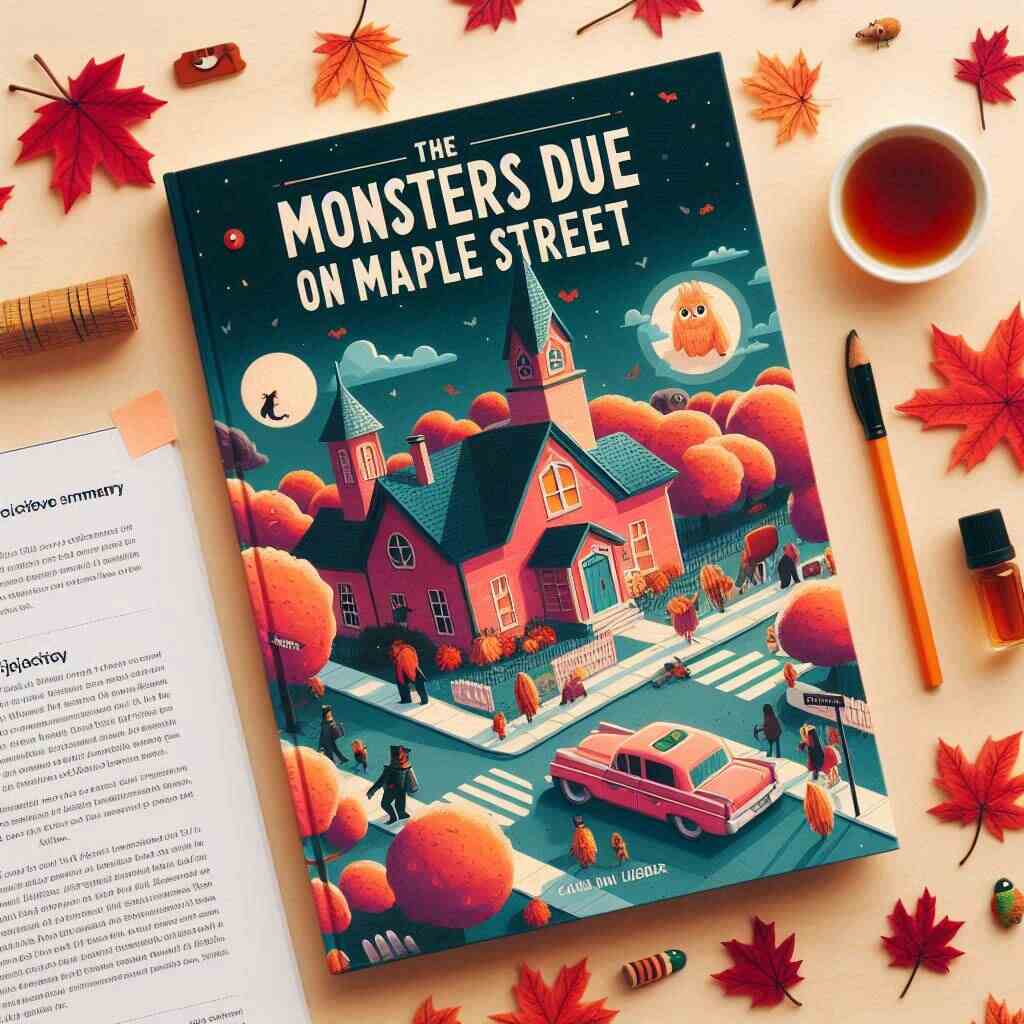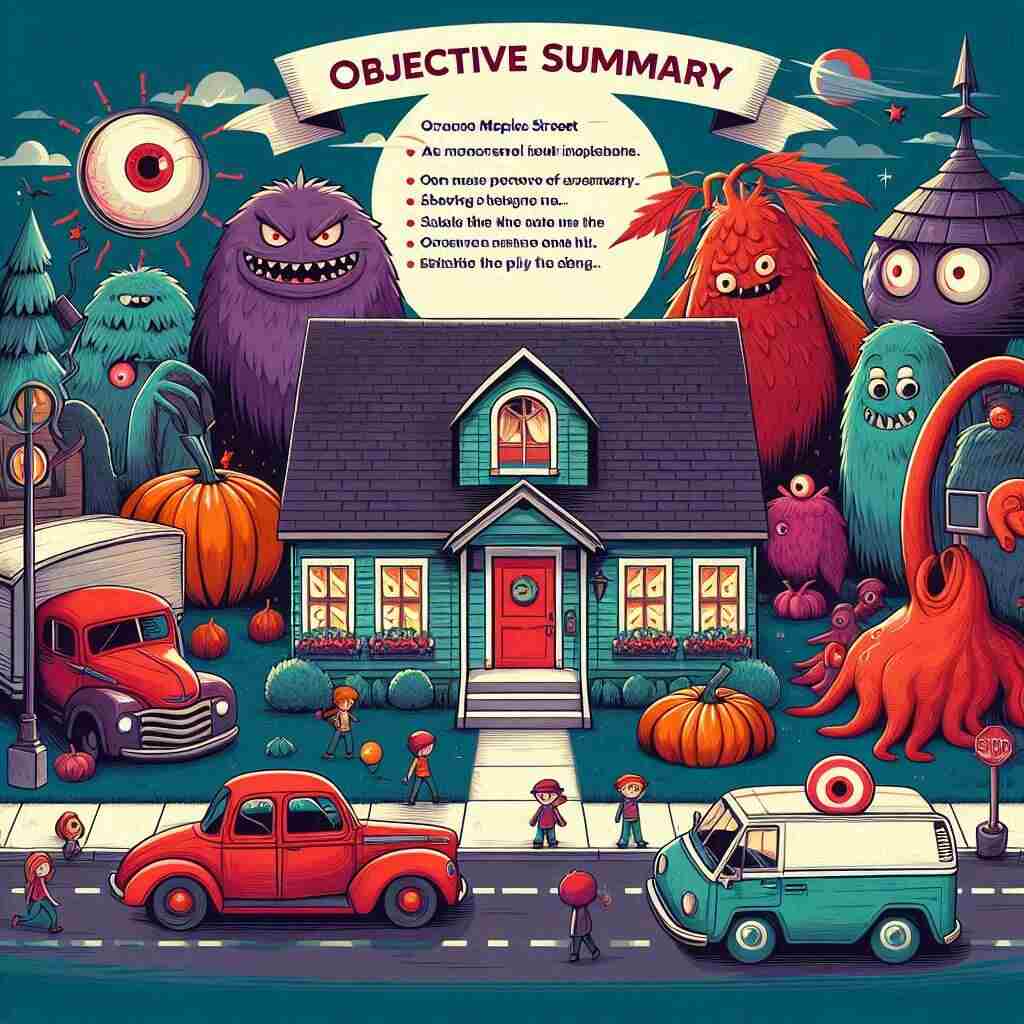Objective Summary of “The Monsters Are Due on Maple Street”
The Monsters Are Due on Maple Street is one of the most memorable episodes of The Twilight Zone. It plays out almost like a psychological experiment: take a quiet American neighborhood, add a mysterious disturbance, and watch how quickly fear and suspicion can tear apart a community. The story highlights how ordinary people, when faced with uncertainty, can turn on each other in destructive ways.
When and Who: Episode Facts

This episode was written by Rod Serling and aired during the very first season of The Twilight Zone in 1960. It is still widely praised today for its timeless commentary on human nature, fear, and mob mentality.
Setting: Maple Street
The story unfolds on Maple Street, a typical mid-century suburban neighborhood. It’s the kind of place with kids playing outside, families sitting on porches, and neighbors chatting across lawns. The setting feels safe and familiar, which makes the unraveling of order all the more striking.
Main Characters

Steve Brand — the voice of reason
Steve is the level-headed neighbor who tries to calm everyone down when fear begins to spread. He appeals to logic and reason, but as panic grows, his voice gets drowned out.
Les Goodman — the suspicious neighbor
Les is an ordinary man, but his unusual luck with machines — like his car mysteriously starting when others won’t — makes him the center of suspicion.
Tommy — the catalyst (the kid with an idea)
Tommy, a young boy, plants the seed of paranoia by suggesting that aliens may be disguised as humans in the neighborhood. His imagination turns into a dangerous theory that takes root.
Don Martin and other neighbors — the crowd
The rest of the neighbors represent the “everyman.” They react with confusion, fear, and eventually aggression as suspicion escalates.
Inciting Incident: The Flash and the Outage

First strange event: the flash of light
The peace of Maple Street is broken by a sudden flash of light and a strange roar overhead. The neighbors are unsettled but unsure what to make of it.
Second strange event: the power and machines fail
Suddenly, all power goes out. Lights, appliances, radios, and even cars stop working. The unexplained blackout raises anxiety and sets the stage for the neighbors to look for answers.
Tommy’s Theory: The Seed of Suspicion
Tommy suggests that aliens are responsible — and worse, that they might already be living among them disguised as humans. While it comes from a child, the idea sparks doubt and fear. Once that thought takes hold, everyone begins looking at each other with suspicion.
How Suspicion Spreads: Small Clues, Big Accusations
Mechanical “proofs” and coincidence
Coincidences quickly become “evidence.” For example, when Les Goodman’s car mysteriously starts on its own, neighbors interpret it as proof that he might be the alien in disguise.
How normal quirks become “evidence”
Everyday behaviors suddenly appear sinister. Someone’s late-night walks, hobbies, or quiet personality are twisted into reasons to distrust them. Innocent quirks become grounds for accusation.
The Turning Point: From Conversation to Confrontation
At first, the neighbors talk nervously about what’s happening. But soon, conversation turns to confrontation. Fear intensifies, and reasoned voices like Steve’s are ignored. The community shifts from calm discussion to direct blame.
Mob Mentality: Scapegoating and Escalation
The neighbors form a mob-like mentality. They interrogate Les, accuse him, and treat coincidences as undeniable proof. What once was a peaceful community quickly becomes divided and hostile.
Climax: Violence and the Breakdown of Order
As tension peaks, panic boils over into violence. Neighbors lash out at one another, and chaos erupts on Maple Street. The once-friendly community becomes unrecognizable as fear replaces trust.
Resolution and Final Reveal
In the closing scene, the audience learns the truth: the strange events were triggered by aliens observing from a distance. They didn’t need to attack directly — by simply cutting power and causing small disturbances, they let human fear destroy the neighborhood from within. The aliens conclude that people are their own worst enemies.
Core Themes and Objective Takeaways
Fear, suspicion, and scapegoating
The story shows how fear makes people desperate for answers, often leading to scapegoating. Once suspicion begins, it’s easy to pin blame on anyone who seems different.
Mass hysteria and democracy’s fragility
The episode highlights how quickly reason and fairness can collapse when fear takes hold. Mob rule replaces justice, and paranoia drowns out rational thought.
Irony: humans as the real “monsters”
The ultimate twist is that humans themselves become the “monsters.” Their own fear and mistrust create the destruction, not the aliens.
Why This Episode Still Resonates Today
Though it first aired in 1960, the story remains just as powerful today. Modern communities face their own versions of fear and paranoia — from conspiracy theories to mistrust fueled by social media. The core lesson is timeless: unchecked fear can tear apart even the most ordinary, friendly neighborhood.
Conclusion
The Monsters Are Due on Maple Street delivers a powerful lesson about human nature. A mysterious flash of light and a power outage are enough to make neighbors turn against one another. Instead of working together, they give in to suspicion and chaos, proving that fear is often more dangerous than any outside threat. In the end, the real monsters aren’t aliens at all — they’re people consumed by paranoia.
FAQs
Q1: What is the main lesson of “The Monsters Are Due on Maple Street”?
The story teaches that fear and suspicion can destroy communities faster than any outside enemy.
Q2: Who wrote the episode?
It was written by Rod Serling, the creator of The Twilight Zone.
Q3: Why do the neighbors suspect Les Goodman?
They accuse Les because his car mysteriously starts when no one else’s does, which they see as suspicious.
Q4: What role does Tommy play?
Tommy introduces the idea that aliens may be disguised as humans, sparking the paranoia.
Q5: How does the story end?
The ending reveals that aliens are behind the disturbances, but they simply watch as humans destroy themselves.
Q6: Who is the real “monster” in the episode?
The real monsters are the neighbors themselves, whose fear and mistrust lead to chaos.
Q7: What genre is the story?
It’s science fiction with strong elements of social commentary and allegory.
Q8: Why is the episode still relevant today?
Because it shows how quickly fear and rumor can spread, a theme that still resonates in modern society.
Q9: What does Steve Brand represent?
Steve represents logic, reason, and calm thinking — qualities that are ultimately ignored.
Q10: What makes this episode so impactful?
Its simple setup and shocking conclusion highlight universal truths about human behavior, making it both entertaining and thought-provoking.







